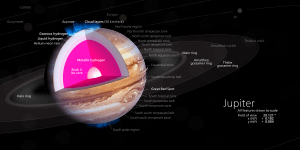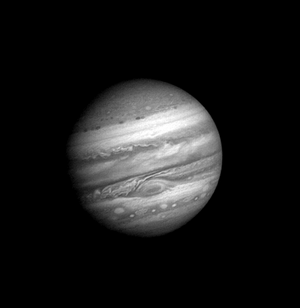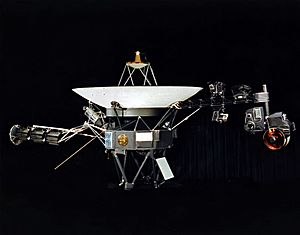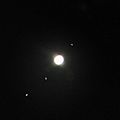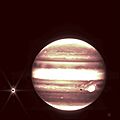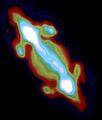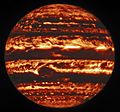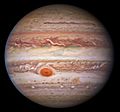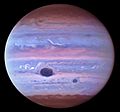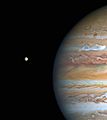Jupiter facts for kids
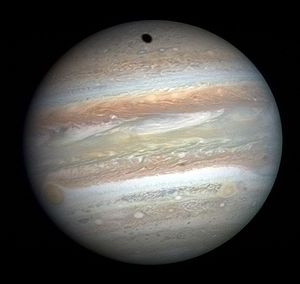
Full disk view of Jupiter in natural colour, with the shadow of its largest moon Ganymede cast onto it and the Great Red Spot at the left horizon.
|
|||||||||||||
| Designations | |||||||||||||
|---|---|---|---|---|---|---|---|---|---|---|---|---|---|
|
Named after
|
Jupiter | ||||||||||||
| Adjectives | Jovian | ||||||||||||
| Orbital characteristics | |||||||||||||
| Epoch J2000 | |||||||||||||
| Aphelion | 5.4570 AU (816.363 million km) | ||||||||||||
| Perihelion | 4.9506 AU (740.595 million km) | ||||||||||||
| 5.2038 AU (778.479 million km) | |||||||||||||
| Eccentricity | 0.0489 | ||||||||||||
|
|||||||||||||
| 398.88 d | |||||||||||||
|
Average orbital speed
|
13.07 km/s (8.12 mi/s) | ||||||||||||
| 20.020° | |||||||||||||
| Inclination |
|
||||||||||||
| 100.464° | |||||||||||||
| 21 January 2023 | |||||||||||||
| 273.867° | |||||||||||||
| Known satellites | 95 (as of 2023[update]) | ||||||||||||
| Physical characteristics | |||||||||||||
|
Mean radius
|
69,911 km (43,441 mi) 10.973 of Earth's |
||||||||||||
|
Equatorial radius
|
71,492 km (44,423 mi) 11.209 R⊕ (of Earth's) 0.10045 R☉ (of Sun's) |
||||||||||||
|
Polar radius
|
66,854 km (41,541 mi) 10.517 of Earth's |
||||||||||||
| Flattening | 0.06487 | ||||||||||||
| 6.1469×1010 km2 (2.3733×1010 sq mi) 120.4 of Earth's |
|||||||||||||
| Volume | 1.4313×1015 km3 (3.434×1014 cu mi) 1,321 of Earth's |
||||||||||||
| Mass | 1.8982×1027 kg (4.1848×1027 lb)
|
||||||||||||
|
Mean density
|
1.326 g/cm3 (0.0479 lb/cu in) | ||||||||||||
| 24.79 m/s2 (81.3 ft/s2) 2.528 g |
|||||||||||||
|
Moment of inertia factor
|
0.2756±0.0006 | ||||||||||||
| 59.5 km/s (37.0 mi/s) | |||||||||||||
| 9.9258 h (9 h 55 m 33 s) | |||||||||||||
|
Sidereal rotation period
|
9.9250 hours (9 h 55 m 30 s) | ||||||||||||
|
Equatorial rotation velocity
|
12.6 km/s (7.8 mi/s; 45,000 km/h) | ||||||||||||
| 3.13° (to orbit) | |||||||||||||
|
North pole right ascension
|
268.057°; 17h 52m 14s | ||||||||||||
|
North pole declination
|
64.495° | ||||||||||||
| Albedo | 0.503 (Bond) 0.538 (geometric) |
||||||||||||
| Temperature | 88 K (−185 °C) (blackbody temperature) | ||||||||||||
|
|||||||||||||
| −2.94 to −1.66 | |||||||||||||
| −9.4 | |||||||||||||
| 29.8" to 50.1" | |||||||||||||
| Atmosphere | |||||||||||||
|
Surface pressure
|
200–600 kPa (30–90 psi) (opaque cloud deck) |
||||||||||||
| 27 km (17 mi) | |||||||||||||
| Composition by volume | |||||||||||||
Jupiter is the largest planet in the Solar System. It is the fifth planet from the Sun. Jupiter is a gas giant, both because it is so large and made up of gas. The other gas giants are Saturn, Uranus, and Neptune.
Jupiter's mass is 1.8986×1027 kg. (318 earths). This is more than twice the mass of all the other planets in the Solar System put together.
Jupiter can be seen even without using a telescope. The ancient Romans named the planet after their King of Gods, Jupiter (Latin: Iuppiter). Jupiter is the third brightest object in the night sky. Only the Earth's moon and Venus are brighter.
Jupiter has 95 moons and probably many more. About 50 of them are very small and less than five kilometres wide. The four largest moons of Jupiter are Io, Europa, Ganymede, and Callisto. They are called the Galilean moons, because Galileo Galilei discovered them. Ganymede is the largest moon in the Solar System. It is larger in diameter than Mercury.
Contents
Name and symbol

Jupiter was named for the king of the gods. The Greeks called him Zeus. The Romans called him Jupiter. The symbol for Jupiter, ![]() , is from the Greek zeta. It has a horizontal stroke⟨Ƶ⟩. This stands as an abbreviation for Zeus.
, is from the Greek zeta. It has a horizontal stroke⟨Ƶ⟩. This stands as an abbreviation for Zeus.
Structure
Jupiter is the biggest planet in the Solar System. Its diameter is 142,984 km. This is eleven times bigger than the diameter of Earth.
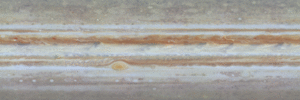
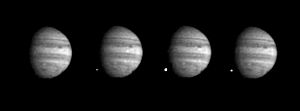
Atmosphere
The atmosphere near the surface of Jupiter is about 88 to 92% hydrogen, 8 to 12% helium, and 1% other gases.
The lower atmosphere is so heated and the pressure so high that helium changes to liquid. It rains down onto the planet. Based on spectroscopy, Jupiter seems to be made of the same gases as Saturn. It is different from Neptune or Uranus. Those two planets have much less hydrogen and helium gas.
The very high temperatures and pressures in Jupiter's core mean scientists cannot tell what materials are there. This cannot be found out, because it is not possible to create the same amount of pressure on Earth.
Above the unknown inner core is an outer core. The outer core of Jupiter is thick, liquid hydrogen. The pressure is high enough to make the hydrogen solid, but then it melts because of the heat.
The planet Jupiter is sometimes called a failed star because it is made of the same elements (hydrogen and helium) as is the Sun, but it is not large enough to have the internal pressure and temperature necessary to cause hydrogen to fuse to helium, the energy source that powers the sun and most other stars.
Mass
Jupiter is twice as massive as all the other planets in the Solar System put together. It gives off more heat than it gets from the sun. Jupiter is 11 times the width of Earth and 318 times as massive. The volume of Jupiter is 1,317 times the volume of Earth. In other words, 1,317 Earth-sized objects could fit inside it.
Cloud layers
Jupiter has many bands of clouds going horizontally across its surface. The light parts are zones and the darker are belts. The zones and belts often interact with each other. This causes huge storms. Wind speeds of 360 kilometres per hour (km/h) are common on Jupiter. To show the difference the strongest tropical storms on Earth are about 100 km/h.
Most of the clouds on Jupiter are made of ammonia. There may also be clouds of water vapor like clouds on Earth. Spacecrafts such as Voyager 1 have seen lightning on the surface of the planet. Scientists think it was water vapor because lightning needs water vapor. These lightning bolts have been measured as up 1,000 times as powerful as those on Earth. The brown and orange colors are caused when sunlight passes through or refracts with the many gases in the atmosphere.
Great Red Spot
One of the biggest features in Jupiter's atmosphere is the Great Red Spot. It is a huge storm which is bigger than the entire Earth. It is on record since at least 1831, and as early as 1665. Images by the Hubble Space Telescope have shown as many as two smaller "red spots" next to the Great Red Spot. Storms can last for hours or as long as hundreds of years in the case of the Great Red Spot.
Magnetic field
Jupiter has a magnetic field like Earth's but 11 times stronger. It also has a magnetosphere much bigger and stronger than Earth's. The field traps radiation belts much stronger than Earth's Van Allen radiation belts, strong enough to endanger any spacecraft travelling past or to Jupiter. The magnetic field is probably caused by the large amounts of liquid metallic hydrogen in the core of Jupiter. The four largest moons of Jupiter and many of the smaller ones orbit or go around the planet within the magnetic field. This protects them from the solar wind. Jupiter's magnetic field is so large, it reaches the orbit of Saturn 7.7 million miles (12 million km) away. The Earth's magnetosphere does not even cover its moon, less than a quarter of a million miles (400,000 km) away. It also experiences large aurorae, which happen when charged particles from the volcanic moon Io land in its atmosphere.
Ring system
Jupiter also has a thin planetary ring system. These rings are difficult to see and were not discovered until 1979 by NASA's Voyager 1 probe. There are four parts to Jupiter's rings. The closest ring to Jupiter is called the Halo Ring. The next ring is called the Main Ring. It is about 6,440 km (4,002 mi) wide and only 30 km (19 mi) thick. The Main and Halo rings of Jupiter are made of small, dark particles. The third and fourth rings, called the Gossamer Rings, are transparent (see through) and are made from microscopic debris and dust. This dust probably comes from small meteors striking the surface of Jupiter's moons. The third ring is called the Amalthea Gossamer Ring, named after moon Amalthea. The outer ring, the Thebe Gossamer Ring, is named after the moon Thebe. The outer edge of this ring is about 220,000 km (136,702 mi) from Jupiter.
Orbit
The orbit of a planet is the time and path it takes to go around the Sun. In the amount of time it takes for Jupiter to orbit the Sun one time, the Earth orbits the Sun 11.86 times. One year on Jupiter is equal to 11.86 years on Earth. The average distance between Jupiter and the Sun is 778 million kilometres. This is five times the distance between Earth and the Sun. Jupiter is not tilted on its axis as much as Earth or Mars. This causes it to have no seasons, for example summer or winter. Jupiter rotates, or spins around very quickly. This causes the planet to bulge in the middle. Jupiter is the fastest spinning planet in the Solar System. It completes one rotation or spin in 10 hours. Because of the bulge, the length of the equator of Jupiter is much longer than the length from pole to pole.
Grand tack hypothesis
The orbit of Jupiter is unusual among star systems. It is usual for giant planets to be much nearer to their stars. Because it is not, it suggests an unusual explanation is needed for the arrangement of the planets in the Solar System.
- "Over the eons, the giant planet roamed toward the center of the Solar System and back out again, at one point moving in about as close as Mars is now. The planet's travels profoundly influenced the Solar System, changing the nature of the asteroid belt and making Mars smaller than it should have been. These details are based on a new model of the early Solar System developed by an international team that includes NASA's Goddard Space Flight Center in Greenbelt, Md."
Research and exploration
From Earth
Jupiter is the third brightest object in the night sky, after the Moon and Venus. The first person known to really study the planet was Galileo Galilei in 1610. He was the first person to see Jupiter's moons Io, Europa, Ganymede and Callisto. This was because he used a telescope, unlike anyone before him.
No new moons were discovered for more than two hundred years. In 1892, astronomer E.E Barnard found a new moon using his observatory in California. He called the moon Amalthea. It was the last of Jupiter's 67 moons to be discovered by human observation through a telescope. In 1994, bits of the comet Shoemaker Levy-9 hit Jupiter. It was the first time people saw a collision between two Solar System objects.
From spacecraft
Seven spacecraft have flown past Jupiter since 1973. These were Pioneer 10 (1973), Pioneer 11 (1974), Voyagers 1 and 2 (1979), Ulysses (1992 and 2004), Cassini (2000) and New Horizons (2007).
The Pioneer missions were the first spacecraft to take close up pictures of Jupiter and its moons. Five years later, the two Voyager spacecraft discovered over 20 new moons. They captured photo evidence of lightning on the night side of Jupiter.
The Ulysses probe was sent to study the Sun. It only went to Jupiter after it had finished its main mission. Ulysses had no cameras so it took no photographs. In 2006, the Cassini spacecraft, on its way to Saturn, took some very good, very clear pictures of the planet. Cassini also found a moon and took a picture of it but it was too far away to show the details.
The Galileo mission in 1995 was the first spacecraft to go into orbit around Jupiter. It flew around the planet for seven years and studied the four biggest moons. It launched a probe into the planet to get information about Jupiter's atmosphere. The probe travelled to a depth of about 150 km before it was crushed by the pressure of all the gas above it. The Galileo spacecraft was also crushed in 2003 when NASA steered the craft into the planet. They did this so that the craft could not crash into Europa, a moon which scientists think might have life.
NASA have sent another spacecraft to Jupiter called Juno. It was launched on August 5, 2011 and arrived at Jupiter on July 4, 2016. NASA published some results from the Juno mission in March 2018. Several other missions have been planned to send spacecraft to Jupiter's moons Europa and Callisto. One called JIMO (Jupiter Icy Moons Orbiter) was cancelled in 2006 because it cost too much money.
Moons
Jupiter has 95 known natural satellites, and it is likely that this number would go up in the future due to improved instrumentation. Of these, 79 are less than 10 km in diameter. The four largest moons are Ganymede, Callisto, Io and Europa (in order of decreasing size), collectively known as the "Galilean moons", and are visible from Earth with binoculars on a clear night.
Galilean moons
The moons discovered by Galileo—Io, Europa, Ganymede, and Callisto—are among the largest in the Solar System. The orbits of Io, Europa, and Ganymede form a pattern known as a Laplace resonance; for every four orbits that Io makes around Jupiter, Europa makes exactly two orbits and Ganymede makes exactly one. This resonance causes the gravitational effects of the three large moons to distort their orbits into elliptical shapes, because each moon receives an extra tug from its neighbours at the same point in every orbit it makes. The tidal force from Jupiter, on the other hand, works to circularize their orbits.
The eccentricity of their orbits causes regular flexing of the three moons' shapes, with Jupiter's gravity stretching them out as they approach it and allowing them to spring back to more spherical shapes as they swing away. The friction created by this tidal flexing generates heat in the interior of the moons. This is seen most dramatically in the volcanic activity of Io (which is subject to the strongest tidal forces), and to a lesser degree in the geological youth of Europa's surface, which indicates recent resurfacing of the moon's exterior.
|
||||||||||||||||||||||||||||||||||||||||||||||||||||||||||
| The Galilean moons Io, Europa, Ganymede, and Callisto (in order of increasing distance from Jupiter) | ||||||||||||||||||||||||||||||||||||||||||||||||||||||||||
Classification
Jupiter's moons were traditionally classified into four groups of four, based on their similar orbital elements. This picture has been complicated by the discovery of numerous small outer moons since 1999. Jupiter's moons are currently divided into several different groups, although there are several moons which are not part of any group.
The eight innermost regular moons, which have nearly circular orbits near the plane of Jupiter's equator, are thought to have formed alongside Jupiter, whilst the remainder are irregular moons and are thought to be captured asteroids or fragments of captured asteroids. The irregular moons within each group may have a common origin, perhaps as a larger moon or captured body that broke up.
| Regular moons | |
|---|---|
| Inner group | The inner group of four small moons all have diameters of less than 200 km, orbit at radii less than 200,000 km, and have orbital inclinations of less than half a degree. |
| Galilean moons | These four moons, discovered by Galileo Galilei and by Simon Marius in parallel, orbit between 400,000 and 2,000,000 km, and are some of the largest moons in the Solar System. |
| Irregular moons | |
| Himalia group | A tightly clustered group of prograde-orbiting moons with orbits around 11,000,000–12,000,000 km from Jupiter. |
| Carpo group | A sparsely populated group of small moons with highly inclined prograde orbits around 16,000,000–17,000,000 km from Jupiter. |
| Ananke group | This group of retrograde-orbiting moons has rather indistinct borders, averaging 21,276,000 km from Jupiter with an average inclination of 149 degrees. |
| Carme group | A tightly clustered group of retrograde-orbiting moons that averages 23,404,000 km from Jupiter with an average inclination of 165 degrees. |
| Pasiphae group | A dispersed and only vaguely distinct retrograde group that covers all the outermost moons. |
Jupiter in the Solar System
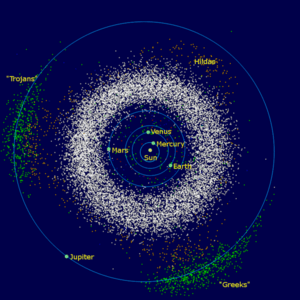
Jupiter's large gravity has had an effect on the Solar System. Jupiter protects the inner planets from comets by pulling them towards itself. Because of this, Jupiter has the most comet impacts in the Solar System.
Two groups of asteroids, called Trojan asteroids, have settled into Jupiter's orbit round the Sun. One group is called the Trojans and the other group is called the Greeks. They go around the Sun at the same time as Jupiter.
Images for kids
-
Close up of the Great Red Spot imaged by the Juno spacecraft in April 2018
-
Orbit of Jupiter and other outer Solar System planets
-
Jupiter viewed in infrared by JWST (July 14, 2022)
-
Brown spots mark Comet Shoemaker–Levy 9's impact sites on Jupiter
See also
 In Spanish: Júpiter (planeta) para niños
In Spanish: Júpiter (planeta) para niños


